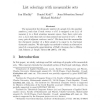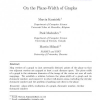751 search results - page 20 / 151 » The Distinguishing Chromatic Number |
DAM
2010
13 years 10 months ago
2010
In the minimum sum edge coloring problem, we aim to assign natural numbers to edges of a graph, so that adjacent edges receive different numbers, and the sum of the numbers assign...
JGT
2008
13 years 9 months ago
2008
The measurable list chromatic number of a graph G is the smallest number such that if each vertex v of G is assigned a set L(v) of measure in a fixed atomless measure space, the...
STOC
1994
ACM
14 years 1 months ago
1994
ACM
We indicate strong non-approximability factors for central problems: N1/4 for Max Clique; N1/10 for Chromatic Number; and 66/65 for Max 3SAT. Underlying the Max Clique result is a...
CORR
2008
Springer
13 years 10 months ago
2008
Springer
Map vertices of a graph to (not necessarily distinct) points of the plane so that two adjacent vertices are mapped at least a unit distance apart. The plane-width of a graph is th...
IPL
2008
13 years 9 months ago
2008
A homomorphism from an oriented graph G to an oriented graph H is an arc-preserving mapping f from V(G) to V(H), that is f(x)f(y) is an arc in H whenever xy is an arc in G. The or...


